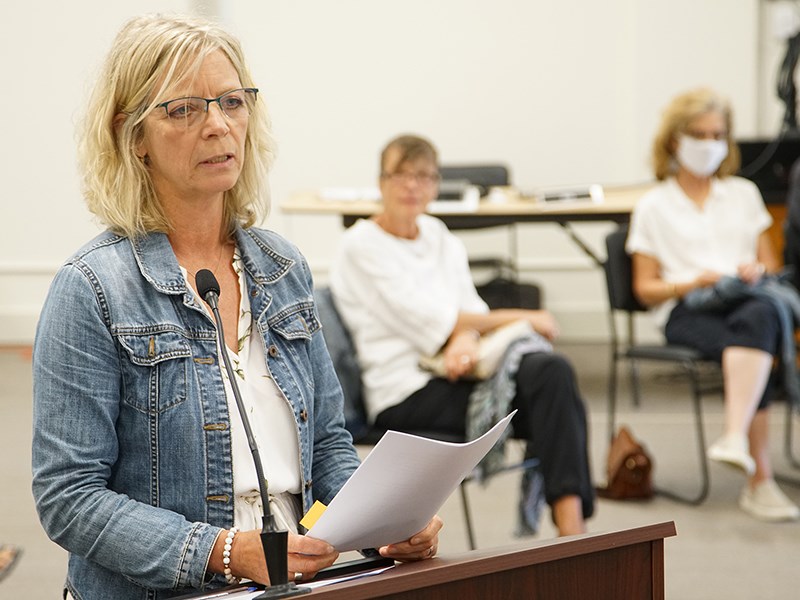Environmental concerns about the new wastewater treatment plant in Townsite were recently expressed to City of Powell River.
Diana Collicutt, vice-president of Townsite Ratepayers Society, speaking to the city’s July 14 committee of the whole meeting, raised questions about the April 2018 environmental study that had been conducted by Associated Engineering, the consulting firm involved in the design of Powell River’s wastewater treatment plant.
Collicutt said the study determined there are no sensitive aquatic habitats or biota identified in the local study area, which involves a two-kilometre radius surrounding the planned liquid waste treatment plant outfall location.
“This scientific finding is concerning,” said Collicutt. “The report is not accurate and lacks important information.”
She said during this past winter, the area where construction will take place and the new outfall will be built was home to the entire population of Steller and California sea lions that reside on the BC coast. Collicutt also said there is a long list of recent, documented animal sightings within the two- to 10-kilometre radius her group is requesting be added for consideration and review in the wastewater environmental study. Some of the biota are on the endangered species list, she added.
“The Associated Engineering study was very limited in its environmental review and did not discuss potential impacts of construction on both marine and terrestrial habitats during bird nesting seasons, when the population of sea lions is present, or when animal migration is in effect,” said Collicutt. “There was no mention in the report that wildlife even exists in the local study area or regional study area. Should we then rely on this report as a comprehensive environmental review when it does not even recognize the abundance of wildlife and aquatic habitat in the area?”
Collicutt said there needs to be more study done in the preplanning stage to identify potential impacts during construction, and how to properly plan for and mitigate negative impacts and potential destruction of bird and mammal habitat areas.
She asked if council would take more proactive measures for environmental protection and require more comprehensive environmental planning, reporting and mitigation measures to be conducted prior to construction.
Councillor George Doubt asked if all of the required federal and provincial environmental studies for the project have been completed and if that includes studies for construction of the outfall, which he thinks is going to be the first project.
“Have we met all of the federal and provincial environmental study requirements for the construction and project overall?” asked Doubt.
Director of infrastructure Tor Birtig said with respect to the permit, the environmental impact study quoted by Collicutt was completed in April 2018. He said it is a regulatory requirement related to the municipal waste regulation and it’s overseen by the federal and provincial ministries.
“That study focuses on the marine receiving environment,” said Birtig. “It takes a look at the placement of the outfall, the marine environment, the volume of effluent as well as how we are treating that same effluent.
“One thing to remember is we are going from four outfalls to one. We are combining them all into one with better treatment levels to meet the new requirements.”
Birtig then outlined several other studies that have taken place since the April 2018 environment study.
“I would say it’s very apparent with this project that environmental protection is a critical component and we are taking appropriate mitigation measures to ensure they are carried out,” said Birtig.
Councillor Jim Palm said one of the reasons the city has been fortunate to get the funding to build the liquid waste treatment plant is because of the serious threat from the department of fisheries and oceans in terms of the current outfalls, which prompted the funding to come along sooner than later.
Doubt said protecting the environment is an important part of why this project exists in the first place. He said there are currently four outfalls discharging sewage into the Salish Sea and it is harmful to wildlife.
“We’ve been ordered to clean that up by various levels of government,” said Doubt. “That’s what we are doing and I think the studies we’ve had are appropriate. The city is doing a good job and our staff is doing a good job of making sure the environment is protected.”
Birtig said there is a monitoring committee that needs to be struck that talks about the effectiveness of the liquid waste management plan.
Collicutt said there has been a lot of work done since April 2018 and the public isn’t aware. She said regarding the monitoring committee, she would like to ask that it be struck as soon as possible to keep up to date with what is going on.
“This is an $80 million project; it’s the biggest project ever for Powell River,” said Collicutt. “None of this information is on the website. A lot of us are left in the dark about what is going on.”
Collicutt was advised that terms of reference for the committee would be produced starting in August.



